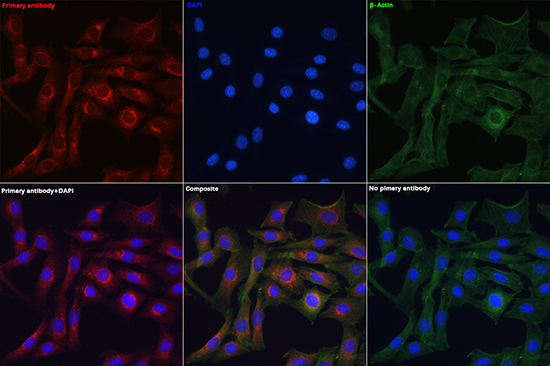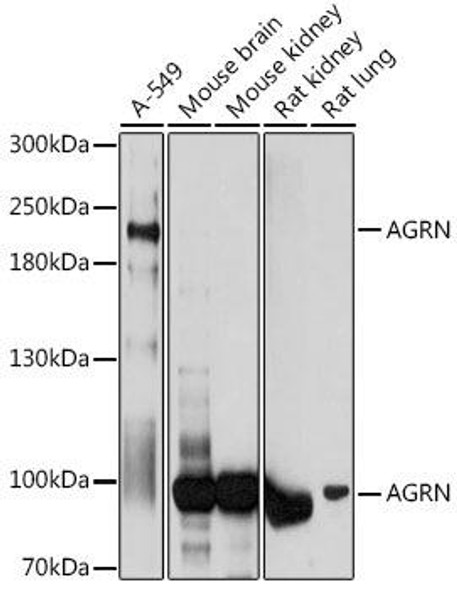Cell Biology Antibodies 3
Anti-GRN Antibody (CAB12440)
- SKU:
- CAB12440
- Product Type:
- Antibody
- Reactivity:
- Human
- Reactivity:
- Mouse
- Host Species:
- Rabbit
- Isotype:
- IgG
- Antibody Type:
- Polyclonal Antibody
- Research Area:
- Cell Biology
Description
| Antibody Name: | Anti-GRN Antibody |
| Antibody SKU: | CAB12440 |
| Antibody Size: | 20uL, 50uL, 100uL |
| Application: | WB IHC IF |
| Reactivity: | Human, Mouse |
| Host Species: | Rabbit |
| Immunogen: | Recombinant fusion protein containing a sequence corresponding to amino acids 281-336 of human GRN (NP_002078.1). |
| Application: | WB IHC IF |
| Recommended Dilution: | WB 1:500 - 1:2000 IHC 1:50 - 1:200 IF 1:50 - 1:200 |
| Reactivity: | Human, Mouse |
| Positive Samples: | A-431 |
| Immunogen: | Recombinant fusion protein containing a sequence corresponding to amino acids 281-336 of human GRN (NP_002078.1). |
| Purification Method: | Affinity purification |
| Storage Buffer: | Store at -20'C. Avoid freeze / thaw cycles. Buffer: PBS with 0.02% sodium azide, 50% glycerol, pH7.3. |
| Isotype: | IgG |
| Sequence: | DVKC DMEV SCPD GYTC CRLQ SGAW GCCP FTQA VCCE DHIH CCPA GFTC DTQK GTCE |
| Gene ID: | 2896 |
| Uniprot: | P28799 |
| Cellular Location: | Secreted |
| Calculated MW: | 44kDa/46kDa/63kDa |
| Observed MW: | 88KDa |
| Synonyms: | GRN, CLN11, GEP, GP88, PCDGF, PEPI, PGRN, granulins |
| Background: | Granulins are a family of secreted, glycosylated peptides that are cleaved from a single precursor protein with 7.5 repeats of a highly conserved 12-cysteine granulin/epithelin motif. The 88 kDa precursor protein, progranulin, is also called proepithelin and PC cell-derived growth factor. Cleavage of the signal peptide produces mature granulin which can be further cleaved into a variety of active, 6 kDa peptides. These smaller cleavage products are named granulin A, granulin B, granulin C, etc. Epithelins 1 and 2 are synonymous with granulins A and B, respectively. Both the peptides and intact granulin protein regulate cell growth. However, different members of the granulin protein family may act as inhibitors, stimulators, or have dual actions on cell growth. Granulin family members are important in normal development, wound healing, and tumorigenesis. |
| UniProt Protein Function: | GRN: Granulins have possible cytokine-like activity. They may play a role in inflammation, wound repair, and tissue remodeling. Defects in GRN are the cause of ubiquitin-positive frontotemporal dementia (UP-FTD); also known as tau- negative frontotemporal dementia linked to chromosome 17. Frontotemporal dementia (FTD) is the second most common cause of dementia in people under the age of 65 years. It is an autosomal dominant neurodegenerative disease. Defects in GRN are the cause of neuronal ceroid lipofuscinosis type 11 (CLN11). A form of neuronal ceroid lipofuscinosis characterized by rapidly progressive visual loss due to retinal dystrophy, seizures, cerebellar ataxia, and cerebellar atrophy. Cognitive decline may also occur. Neuronal ceroid lipofuscinoses are progressive neurodegenerative, lysosomal storage diseases characterized by intracellular accumulation of autofluorescent liposomal material. Belongs to the granulin family. 2 isoforms of the human protein are produced by alternative splicing. |
| UniProt Protein Details: | Protein type:Secreted; Secreted, signal peptide Chromosomal Location of Human Ortholog: 17q21.32 Cellular Component: intracellular membrane-bound organelle Molecular Function:growth factor activity; protein binding Disease: Ceroid Lipofuscinosis, Neuronal, 11; Frontotemporal Lobar Degeneration With Tdp43 Inclusions, Grn-related |
| NCBI Summary: | Granulins are a family of secreted, glycosylated peptides that are cleaved from a single precursor protein with 7.5 repeats of a highly conserved 12-cysteine granulin/epithelin motif. The 88 kDa precursor protein, progranulin, is also called proepithelin and PC cell-derived growth factor. Cleavage of the signal peptide produces mature granulin which can be further cleaved into a variety of active, 6 kDa peptides. These smaller cleavage products are named granulin A, granulin B, granulin C, etc. Epithelins 1 and 2 are synonymous with granulins A and B, respectively. Both the peptides and intact granulin protein regulate cell growth. However, different members of the granulin protein family may act as inhibitors, stimulators, or have dual actions on cell growth. Granulin family members are important in normal development, wound healing, and tumorigenesis. [provided by RefSeq, Jul 2008] |
| UniProt Code: | P28799 |
| NCBI GenInfo Identifier: | 77416865 |
| NCBI Gene ID: | 2896 |
| NCBI Accession: | P28799.2 |
| UniProt Secondary Accession: | P28799,P23781, P23782, P23783, P23784, Q53HQ8, Q53Y88 Q540U8, Q9BWE7, Q9H8S1, Q9UCH0, D3DX55, |
| UniProt Related Accession: | P28799 |
| Molecular Weight: | 44,132 Da |
| NCBI Full Name: | Granulins |
| NCBI Synonym Full Names: | granulin |
| NCBI Official Symbol: | GRN |
| NCBI Official Synonym Symbols: | GEP; GP88; PEPI; PGRN; CLN11; PCDGF |
| NCBI Protein Information: | granulins |
| UniProt Protein Name: | Granulins |
| UniProt Synonym Protein Names: | Proepithelin; PEPI |
| Protein Family: | Granulin |
| UniProt Gene Name: | GRN |
| UniProt Entry Name: | GRN_HUMAN |
View AllClose









